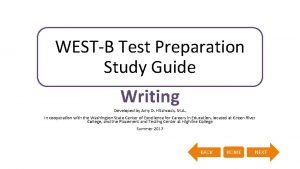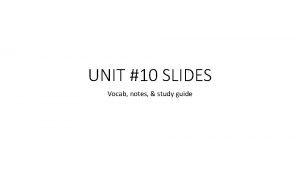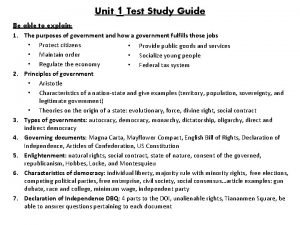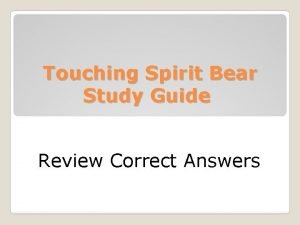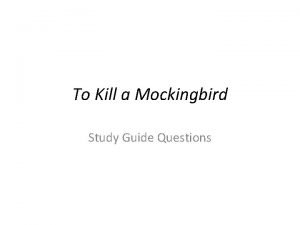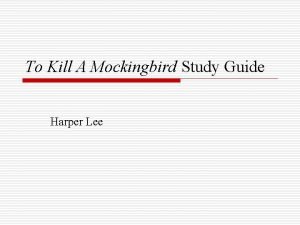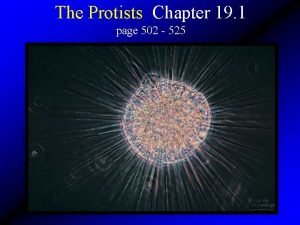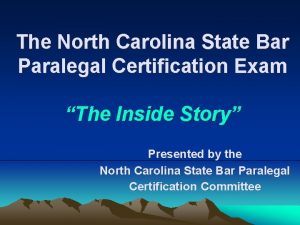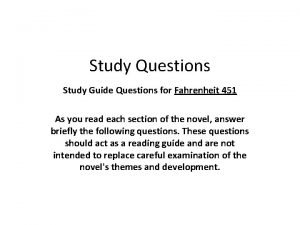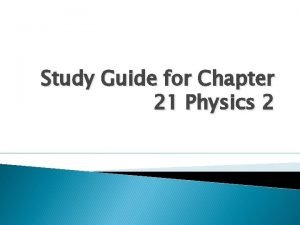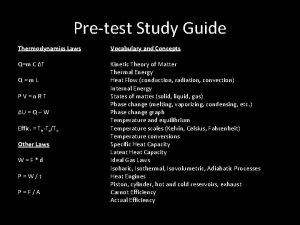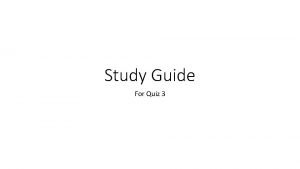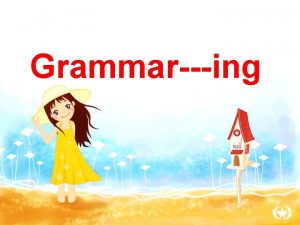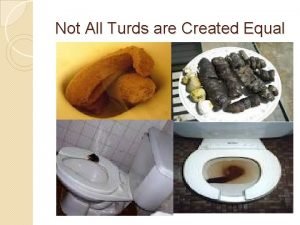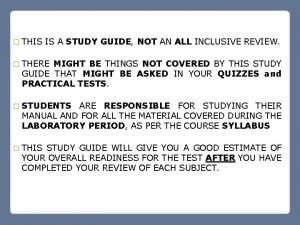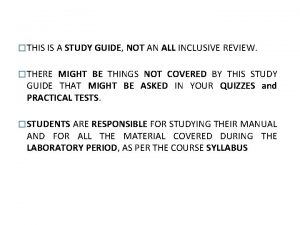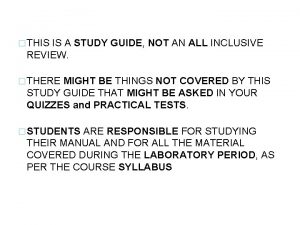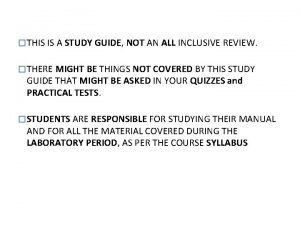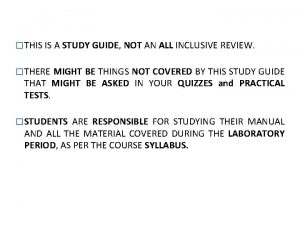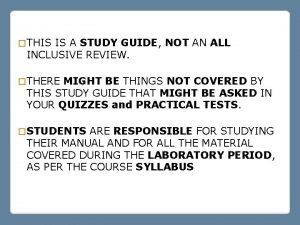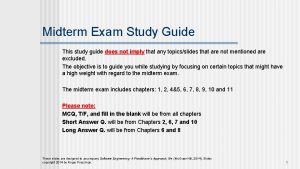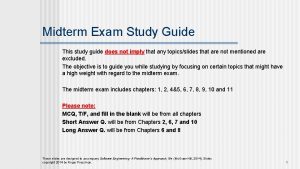THIS IS A STUDY GUIDE NOT AN ALL

















- Slides: 17

� THIS IS A STUDY GUIDE, NOT AN ALL INCLUSIVE REVIEW. � THERE MIGHT BE THINGS NOT COVERED BY THIS STUDY GUIDE THAT MIGHT BE ASKED IN YOUR QUIZZES and PRACTICAL TESTS. � STUDENTS ARE RESPONSIBLE FOR STUDYING THEIR MANUAL AND FOR ALL THE MATERIAL COVERED DURING THE LABORATORY PERIOD, AS PER THE COURSE SYLLABUS

Lab # 1 Blood

-Blood It is the liquid medium in which these substance travel. The Circulatory System It transports substances from place to place in the body. -Cardiovascular System Blood vessels They ensure the proper routing of blood to its destination. Heart It is the pump that keeps the blood flowing.

Blood Plasma It is the liquid matrix where the formed elements are suspended. Components of Blood Formed elements Cells and cell fragments Water (92%) Proteins Nutrients Electrolytes Nitrogenous wastes Hormones Gases Erythrocytes (red blood cells, RBCs) Leukocytes (White blood cells, WBCs) - Granulocytes - Agranulocytes Platelets Neutrophils Eosinophils Basophils Lymphocytes Monocytes

Formed Elements of Blood Monocyte Small lymphocyte Platelets Neutrophil Eosinophil Small lymphocyte Erythrocyte Neutrophil Monocyte Large lymphocyte Neutrophil Basophil

Formed elements Cells and cell fragments Erythrocytes (red blood cells, RBCs) Leukocytes (White blood cells, WBCs) - Granulocytes - Agranulocytes Platelets Neutrophils Eosinophils Basophils Lymphocytes Monocytes Erythrocytes (red blood cells, RBCs) Functions: 1 - They carry oxygen from lungs to cell tissues 2 - They pick up carbon dioxide from tissues and bring to lungs Insufficient RBCs may kill in few minutes due to lack of oxygen to tissues

Leukocytes The leucocytes are the least abundant formed elements (5, 000 to 10, 000 WBCs/m L). They differ from erythrocytes in that they retain their organelles throughout life. The general function of the leukocytes is protection against infectious microorganisms and other pathogens. - Granulocytes Neutrophils Eosinophils Basophils - Agranulocytes Lymphocytes Monocytes Leukocytes (White blood cells, WBCs)

Granulocytes They have specific granules, which contain enzymes and other chemicals employed in defense against pathogens. Neutrophils Eosinophils Basophils The most abundant (60 -70% of circulating leukocytes). Nucleus with 3 to 5 lobules connected by slender nuclear strands (polymorphonuclear leukocytes). Reddish to violet specific granules, which take up histological stains at p. H 7. They are about 2% to 4% of the circulating leukocytes. Nucleus with 2 lobules connected by a thin strand. Coarse rosy to orange-colored specific granules, which take up histological stains at acidic p. H. They are the rarest of the WBCs (less than 0. 5% to 1% of the WBC count). Nucleus largely hidden by the granules. Abundant, very coarse, dark violet specific granules, which take up histological stains at basic p. H. Functions: 1 - Phagocytosis of bacteria. 2 - They release antimicrobial chemicals. The neutrophil count rises (neutrophilia) in response to bacterial infection. Functions: 1 -Phagocytosis of antigenantibody complexes, allergens, and inflammatory chemicals. 2 - They release enzymes to destroy large parasites. They increase in parasitic infections and allergies. Functions: 1 - They secrete histamine (vasodilator), which speeds flow of blood to an injured area (inflammation). 2 - They secrete heparin (anticoagulant), which promotes the mobility of other WBCs in the area (inflammation).

Agranulocytes They also contains granules but they are nonspecific granules (lysosomes containing enzymes). Lymphocytes There are several classes of lymphocytes with different immune functions, but they look alike through the light microscope. They are the principal effector cells of the immune system. Monocytes They are second to neutrophils in abundance (25% to 33%). They are the smallest WBCs (5 to 17 mm in diameter). Large and medium lymphocytes are usually seen in connective tissues. Small lymphocytes are the most common circulating lymphocytes. Round, ovoid or slightly dimpled nucleus, which stains dark violet and fills nearly the entire cell in small lymphocytes. They are the largest WBCs, often two or three times the diameter of an RBC. They are about 3% to 8% of WBC count. The nucleus is large and clearly visible, often light violet. It is typically ovoid, kidney-shaped, or horseshoe-shaped. The cytoplasm contains fine granules. Functions: 1 -They destroy cells (cancer, foreign, and cells infected by viruses). 2 -They “present” antigens to activate other immune cells. 3 - They coordinate actions of other immune cells. 4 - They produce and secrete antibodies. 5 - They memory. provide immune Functions: 1 - They leave bloodstream and transform into macrophages, which 2 -Phagocytize pathogens and debris 3 -“Present” antigens to activate other immune cells. These macrphages are called antigen presenting cells (APCs)

Platelet Form and Function Pseudopod Lysosome Open canalicular system Mitochondrion Granule Platelets are not cells but small fragments of marrow cells called megacaryocytes. They are the second most abundant formed elements, after erythrocytes. Normal count from 130, 000 to 400, 000. Functions of Platelets 1 - They secret vasoconstrictors that stimulate spasmodic constriction of blood vessels and thus help reduce blood loss. 2 - They stick together to form temporary platelet plugs to seal small breaks. 3 - They secrete procoagulants or clotting factors, which promote clotting.

Blood Types Blood types and transfusion compatibility are a matter of interaction between plasma protein and erythrocytes. The plasma membrane of the erythrocytes contains glycoproteins on the outer surface that can act as antigens. That means that they can interact with the corresponding antibodies. The ABO Group Type A Type B Type A B Type O

Plasma contains antibodies against surface antigens that are not present on self red blood cells. Anti-B antibodies Anti-A antibodies Neither anti-A nor anti -B antibodies Anti-A and anti-B antibodies That is why foreign erythrocytes are rejected by the immune system.

When antibodies attack, the foreign cells agglutinate (clump together). This process is called agglutination. + Ab Agglutination The antigens that determine the blood types are called agglutinogens, and the corresponding antibodies are called agglutinins

ABO Blood Typing Control Blood Type A B AB O

The Rh Group The Rh blood group is named for the rhesus monkey, the animal in which the Rh antigens were discovered in 1940. This group include numerous antigens (C, D, E). Antigen D is by far the most reactive and it is used for Rh typing. Rh + D D Rh D D No anti-D antibodies If the person is exposed to Rh antigen produces antibodies

Rh Blood Typing Anti Rh Control Blood Type Rh + Rh -

ABO and Rh Blood Typing Control Anti-A Anti-B Control Anti-Rh Anti-A Anti-B Anti-Rh A- AB- A+ AB+ B- O- B+ O+
 Not genuine, not true, not valid
Not genuine, not true, not valid Edna st vincent millay love is not all
Edna st vincent millay love is not all Name all the rays
Name all the rays World geography spring final review
World geography spring final review West b study guide
West b study guide Unit 10 study guide answer key
Unit 10 study guide answer key Unit 1 test study guide
Unit 1 test study guide Fall semester exam review us history
Fall semester exam review us history Tuesdays with morrie discussion questions by chapter
Tuesdays with morrie discussion questions by chapter Touching spirit bear study guide
Touching spirit bear study guide To kill a mockingbird study guide questions
To kill a mockingbird study guide questions To kill a mockingbird study guide
To kill a mockingbird study guide Chapter 19 protists study guide answers
Chapter 19 protists study guide answers Nc paralegal certification
Nc paralegal certification Study guide fahrenheit 451
Study guide fahrenheit 451 Physics 2 study guide
Physics 2 study guide Define compound machines
Define compound machines Thermodynamics study guide
Thermodynamics study guide




